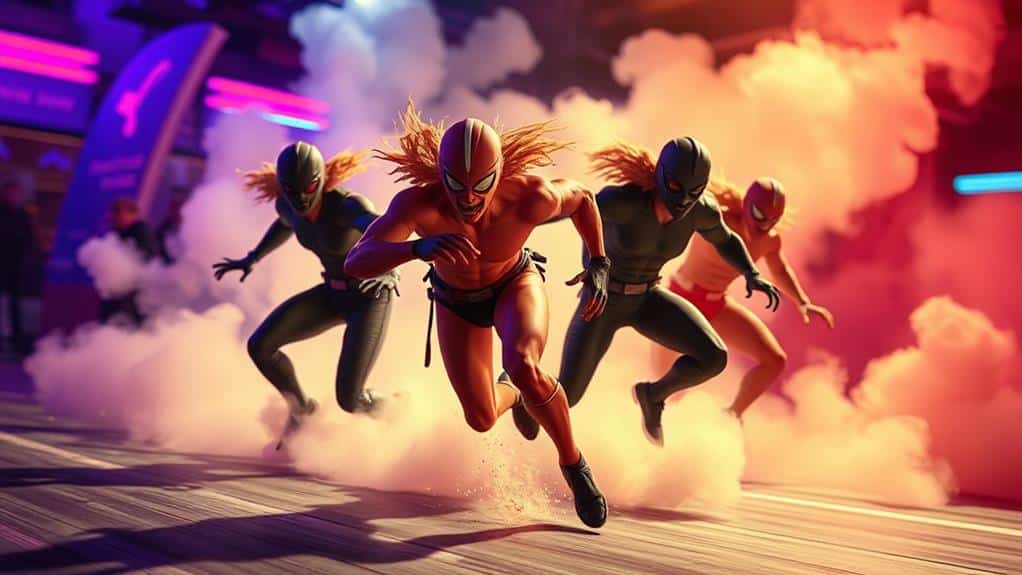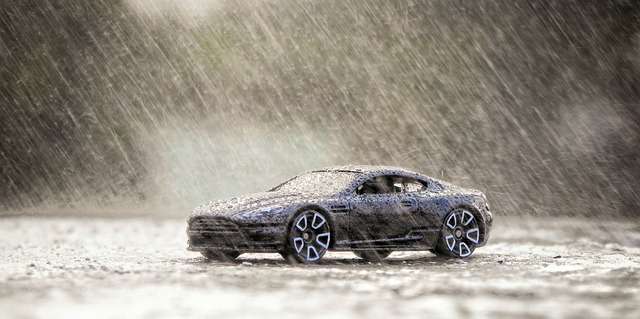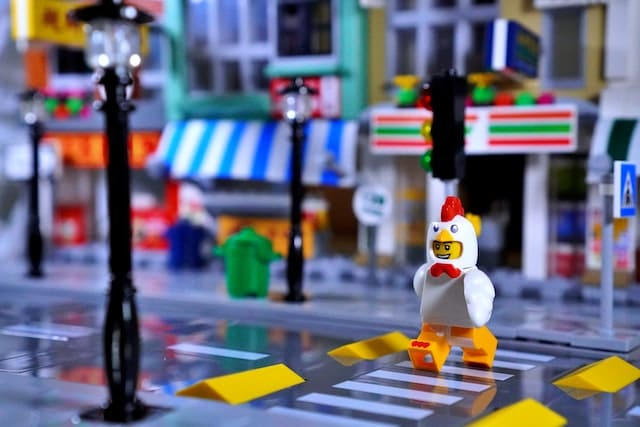To capture motion in action figure photography, start by mastering shutter speed. A fast shutter speed freezes action, while a slower speed creates a dynamic blur effect. Guarantee you have sufficient lighting—natural light offers authenticity, but you can control artificial light for drama. Choose action figures with high articulation for expressive poses and place them in dynamic positions like leaps or swings. Use props and backdrops to create a rich narrative, guaranteeing each element adds to the scene. Adjust your camera settings for proper exposure and stability. Dive deeper to explore how lighting choices and post-processing can enhance your images. To truly elevate your shots, experiment with different angles and perspectives to amplify the sense of movement and storytelling. Finding the perfect camera settings for motion can take practice, so don’t hesitate to adjust your aperture, ISO, and focus points to achieve crisp or deliberately blurred effects. Lastly, post-processing allows you to fine-tune colors, shadows, and highlights, ensuring your final image captures the energy and excitement of the scene.
Understanding Motion in Photography
Capturing motion in photography is all about freezing a moment in time or conveying a sense of movement, and it's a skill worth mastering, especially when shooting action figures. To achieve this, you need to understand the basics of shutter speed. A fast shutter speed, like 1/1000 of a second, freezes motion, making it perfect if you want to capture your action figure in a mid-air leap. On the other hand, a slow shutter speed can blur motion, which can be used creatively to suggest movement.
Understanding light is vital too. When using fast shutter speeds, your camera's sensor receives less light, so you'll need to compensate by adjusting your aperture or ISO. Mastering these settings guarantees your figures are well-lit and sharp.
Don't ignore the composition. The rule of thirds can guide your subject placement, guaranteeing that the action figure looks dynamic and not just centered. Experiment with angles; a low angle can make your figure appear more heroic, adding drama to the motion.
Choosing the Perfect Action Figure
Selecting the right action figure is essential for compelling photography. You want a figure that not only fits the theme of your shoot but also provides the flexibility needed for dynamic poses. Start by considering the articulation points. More articulation means greater movement possibilities, which can help convey motion and emotion. Look for figures with multiple joints in the arms, legs, and torso to maximize expression.
Next, examine the figure's details and accessories. High-quality details can enhance realism, making your photos more engaging. Accessories like weapons or interchangeable hands add versatility, allowing you to tell a wider range of stories. Here's a quick comparison table to guide your choice:
| Aspect | Importance | Tips |
|---|---|---|
| Articulation | Essential for movement | Look for 20+ points of joint |
| Details | Enhances realism | Avoid cheap paint jobs |
| Accessories | Adds versatility | Choose diverse extras |
Setting Up Your Scene

When it comes to setting up your scene, attention to detail can transform an ordinary photo into something extraordinary. You'll want to reflect on the environment where your action figure will come to life. Think about the story you're trying to tell. Are they in the middle of a fierce battle or exploring a serene landscape? Choose a backdrop that enhances this narrative. Use props to add depth and context, but avoid cluttering the scene. Every element should serve a purpose.
Lighting plays an essential role in creating mood and highlighting movement. Natural light is an excellent choice, especially during golden hour, but sometimes artificial lighting offers more control. Experiment with different angles and intensities to achieve the desired effect. Shadows can add drama, so don't shy away from using them creatively.
Position your action figure with intention. Think about dynamic poses that convey motion, like a leap or a swing. Secure your figure with support if necessary, but make certain it's hidden from the camera's view. Remember, the goal is to create a scene that feels alive and compelling. With the right setup, your action figure photography will captivate every viewer.
Mastering Shutter Speed Techniques
Timing is everything in action figure photography, especially when you're mastering shutter speed techniques. Your control over shutter speed can transform static figures into dynamic scenes, capturing the essence of action. Here's how you can effectively use shutter speed to elevate your shots.
Start by understanding how shutter speed affects motion. A fast shutter speed, like 1/1000 of a second, freezes action, ideal for capturing mid-air jumps or fast movements. Conversely, a slow shutter speed, such as 1/30 or slower, introduces motion blur, creating dramatic effects like a swinging sword or flowing cape.
When choosing your shutter speed, consider these factors:
- Desired Effect: Determine if you want a crisp, frozen moment or a blurred dynamic motion.
- Lighting Conditions: Faster speeds require more light, so adjust accordingly.
- Camera Stability: Use a tripod for slower speeds to prevent unwanted blur.
- Figure's Action: Match the speed to the action's intensity for realistic results.
Experimentation is key. Try different speeds to see what works best for your scene and vision. By mastering these techniques, you'll bring your action figures to life, capturing the thrill of motion in every shot.
Utilizing Artificial and Natural Light

While mastering action figure photography, your choice between artificial and natural light dramatically impacts the mood and detail of your shots. Natural light offers a soft, authentic feel, ideal for capturing realistic scenes. It changes throughout the day, providing different opportunities for creativity. Morning and late afternoon light, known as the golden hours, deliver warm tones and gentle shadows, adding depth to your compositions. However, natural light can be unpredictable and may require you to adapt quickly to changing conditions.
On the other hand, artificial light provides control and consistency. You can adjust the intensity, direction, and color to suit your vision. Using desk lamps or LED panels allows you to highlight specific features of your action figures, emphasizing motion or creating dramatic effects. Softboxes and diffusers can help soften harsh lighting, reducing unwanted shadows and glare.
Experiment with both lighting types to discover what best suits your style. Mix natural and artificial light to create unique effects, blending realism with fantasy. Remember, your lighting choices can evoke emotion and bring your action figures to life, making them appear dynamic and engaging. Through practice and experimentation, you'll master the art of lighting in action figure photography.
Post-Processing for Dynamic Effects
Having explored the impact of lighting on your action figure photography, it's time to elevate your work through post-processing for dynamic effects. This stage lets you transform a good photo into something extraordinary by emphasizing motion and energy. Start by using software like Photoshop or Lightroom to manipulate your images. You can enhance the sense of movement and drama, making your figures leap off the screen.
Consider these techniques to add dynamic effects:
- Motion Blur: Apply a subtle motion blur to create the illusion of speed. Adjust the direction and strength to match your scene's dynamics.
- Lighting Effects: Enhance highlights and shadows to add depth and focus. Use dodge and burn tools to control light intensity and direction.
- Color Grading: Adjust colors to set the mood and atmosphere. Cool tones can convey urgency, while warm tones add excitement.
- Layer Compositing: Combine multiple exposures to create complex scenes. Blend layers to simulate action, like dust clouds or flying debris.
Frequently Asked Questions
How Can I Create Realistic Action Poses With My Figures?
Start by studying dynamic poses in comics or sports. Use joints creatively to mimic real movement. Experiment with angles to enhance realism. Add props or accessories for context. Lighting can dramatize action, so don't overlook it.
What Camera Equipment Is Best for Capturing Motion in Action Figure Photography?
Oh, you don't want to capture blurry motion? A DSLR with a fast lens and a tripod will do wonders. Don't forget that lighting setup; it's not like your action figures are movie stars or anything.
Can Smartphone Cameras Effectively Capture Motion in Action Figure Photography?
Yes, you can use smartphone cameras to capture motion effectively. Make sure you've got good lighting and use burst mode or a high shutter speed app. Don't forget to stabilize your phone for sharper shots.
What Are Some Common Mistakes to Avoid When Photographing Action Figures in Motion?
Don't bite off more than you can chew by overcrowding your frame. Avoid poor lighting and unstable cameras. Make certain your background isn't distracting. Keep an eye on your focus and don't forget to experiment with angles.
How Do I Convey a Sense of Scale With Action Figures?
Use background elements like household objects or natural settings to show size differences. Incorporate perspective by placing figures closer or farther from the camera. Experiment with angles to enhance depth, making the action figure's scale more apparent.
At a Glance
You've now got the tools to capture stunning motion in action figure photography. Remember, a study found that 90% of people respond emotionally to images with dynamic movement. So, use this to your advantage! Choose the right action figure, set up an engaging scene, and play with shutter speeds and lighting. Don't forget post-processing to enhance those dynamic effects. With practice, you'll create fascinating images that truly bring your action figures to life.





